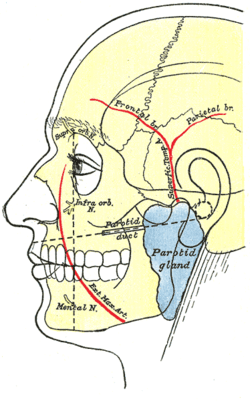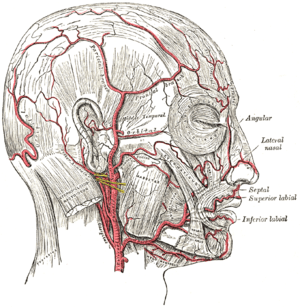Superficial temporal artery
| Superficial temporal artery | |
|---|---|
 Outline of side of face, showing chief surface markings. (Superficial temporal a. visible at center, to left of ear.) | |
|
Superficial dissection of the right side of the neck, showing the carotid and subclavian arteries. | |
| Details | |
| Source | External carotid artery |
| Branches |
Transverse facial artery Middle temporal artery Anterior auricular branch frontal branch parietal branch |
| Vein | superficial temporal vein |
| Supplies | temple, scalp |
| Identifiers | |
| Latin | arteria temporalis superficialis |
| TA | A12.2.05.045 |
| FMA | 49650 |
In human anatomy, the superficial temporal artery is a major artery of the head. It arises from the external carotid artery when it bifurcates into the superficial temporal artery and maxillary artery.
Its pulse is palpable superior to the zygomatic arch, anterior and superior to the tragus.
Course
The superficial temporal artery is the smaller of two terminal branches that bifurcate superiorly from the external carotid. Based on its direction, the superficial temporal artery appears to be a continuation of the external carotid.
It begins in the substance of the parotid gland, behind the neck of the mandible, and passes superficially over the posterior root of the zygomatic process of the temporal bone; about 5 cm. above this process it divides into two branches, a frontal and a parietal.
Relations
As it crosses the zygomatic process, it is covered by the Auricularis anterior muscle, and by a dense fascia; it is crossed by the temporal and zygomatic branches of the facial nerve and one or two veins, and is accompanied by the auriculotemporal nerve, which lies immediately behind it.
The superficial temporal artery anastomoses with (among others) the supraorbital artery of the internal carotid artery.
Clinical relevance
The superficial temporal artery is often affected in giant-cell arteritis and biopsied if the diagnosis is suspected.
Migraine attacks can occur when the temporal artery enlarges.
Additional images
 The arteries of the face and scalp.
The arteries of the face and scalp. Plan of branches of internal maxillary artery.
Plan of branches of internal maxillary artery. Plan of branches of internal maxillary artery.
Plan of branches of internal maxillary artery. Bloodvessels of the eyelids, front view.
Bloodvessels of the eyelids, front view. Lateral head anatomy detail
Lateral head anatomy detail Head anatomy anterior view
Head anatomy anterior view- Superficial temporal artery
- Superficial temporal artery
References
- This article incorporates text in the public domain from the 20th edition of Gray's Anatomy (1918)
External links
- lesson4 at The Anatomy Lesson by Wesley Norman (Georgetown University) (parotid4, infratempfossaart)
- Angiogram of the superficial temporal artery
- Diagram at stchas.edu
- http://www.dartmouth.edu/~humananatomy/figures/chapter_47/47-2.HTMArteriesoftheheadandneckCCECsup.thyroidsuperiorlaryngealsternocleidomastoidbranchinfrahyoidbranchcricothyroidbranchglandularbranchesasc.pharyngealposteriormeningealpharyngealbranchesinferiortympaniclingualsuprahyoiddorsallingualdeeplingualsublingualfacialcervicalbranches(ascendingpalatine,tonsillar,submental,glandular)facialbranches(inferiorlabialsuperiorlabial/nasalseptumlateralnasalangular)occipitalsternocleidomastoidmeningealoccipitalauriculardescendingpost.auricularstylomastoidstapedialauricularoccipitalParotidsup.temporaltransversefacialmiddletemporal(zygomatico-orbital)anteriorauricularfrontalparietalmaxillary1stpart/mandibularanteriortympanicdeepauricularmiddlemeningeal(superiortympanic,petrosal)accessorymeningealinferioralveolar(mental,mylohyoid)2ndpart/pterygoidtomusclesofmastication(deeptemporal,pterygoid,masseteric)buccal3rdpart/pterygopalatineposteriorsuperioralveolarinfraorbital(anteriorsuperioralveolar)descendingpalatine(greaterpalatine,lesserpalatine)arteryofthepterygoidcanalsphenopalatine(posteriorseptalbranches,posteriorlateralnasal)pharyngealICcervicalcarotidsinuspetrousVidiancaroticotympaniccavernous/ophthalmicorbitalgroup:anteriorethmoidalposteriorethmoidallacrimal(lateralpalpebral)medialpalpebralterminal(supraorbital,supratrochlear,dorsalnasal)oculargroup:centralretinalciliary(shortposterior,longposterior,anterior)Circulusarteriosusmajorhypophysial(superior,inferior)brainCircleofWillisACA(anteriorcommunicating,medialstriate,Orbitofrontalartery)MCA(anterolateralcentral,Prefrontalartery,Superiorterminalbranch,Inferiorterminalbranch,Anteriortemporalbranch)posteriorcommunicatinganteriorchoroidalSCvertebralarterymeningealspinal(posterior,anterior)basilar:pontinelabyrinthinecerebellar(AICA,SCA,PICA)cerebral(PCA)thyrocervicaltrunkinferiorthyroidinferiorlaryngealtrachealesophagealascendingcervicalpharyngealglandularbranchestransversecervicalsuperficialbranchdeepbranch/dorsalscapularscapularanastomosissuprascapularacromialbranchscapularanastomosiscostocervicaltrunkdeepcervicalSupremeIntercostalartery